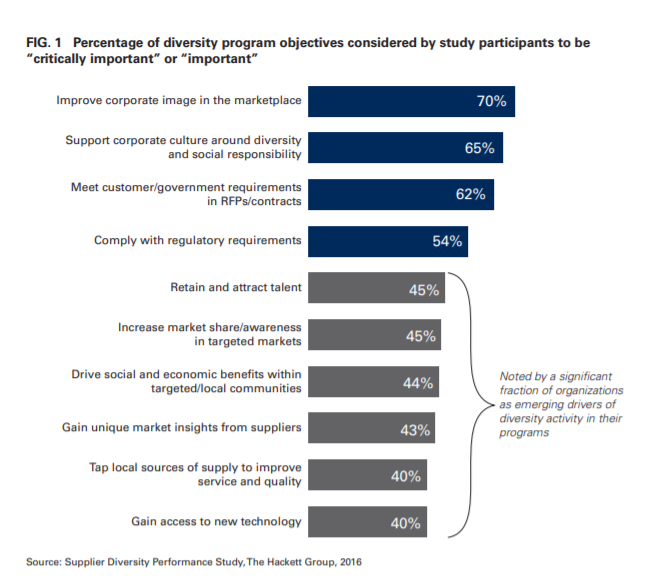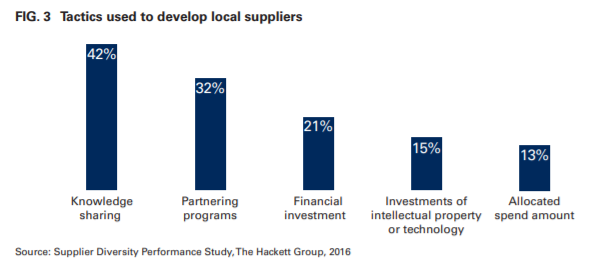You can make ethical decisions in diverse suppliers — and also make a positive impact on the bottom line
The Business Roundtable recently released a high-profile “Statement on the Purpose of a Corporation.”
What they are calling Common-Good Capitalism is a hot topic these days with politicians descrying the current state of capitalist affairs and promoting concepts like “common-good capitalism.”
A prior, more fundamental question is, “What is the purpose of a corporation?” something the Business Roundtable endeavors to answer after laying out a list of commitments most notably, “Dealing fairly and ethically with our suppliers.”
“Each of our stakeholders is essential. We commit to deliver value to all of them, for the future success of our companies, our communities, and our country.”
A company, in this articulated vision, is an artificial construct generating value by providing goods and services, sharing the value it creates in an economically and social optimal way across its different “stakeholders:” government, management, workers, owners of capital, and communities.
We live in remarkable times.
The balance between different stakeholders is a topic of debate.
Some would argue that optimality is driven by the amount of value any putative distribution can create. Some allocations of value lead to a bigger pie than others.
Other argue that the fairness of the distribution is equally or more important than the size of the pie. Why? Because fairness implies sustainability. A company can generate much more cumulative value over time with a fair distribution than one that is perceived to be inconsistent with the times.
And the times, they are a changin’, as the bard wrote.
An important part of the shifting perspective on balance and fairness stems from our changing demographics. Women make up a greater percentage of the workforce and of the entrepreneurial class. There are more minorities proportionally than there used to be. We are more sensitive to the historical injustice of the treatment of indigenous peoples. We are grateful for the sacrifices of men and women who were disabled in service to their country, as we should be.
From the 2016 Hackett Supplier Diversity Study:

Yet, according to UPS, there are big problems.
“According to the 2019 Supplier Diversity Study conducted by the Hackett Group, supplier diversity programs hit only half of their intended goals, and more than three-fourths of corporations say they lack funding for outreach and training.
“This is not how critical business functions typically work, and no amount of CEO statements or awards banquets can overcome the level of misalignment between supplier diversity and corporate strategy.”
More from the UPS citation of the Hackett study on diversity:
“Today, two-thirds of corporations find it difficult to get the organization to adhere to supplier diversity program policy …”
There’s the rub.
For supplier diversity to really take hold, everyone involved needs to understand why it’s important for generating value, to making the pie larger and/or more sustainable.
And it needs to be easier for these diverse suppliers to engage with large corporations. This means better user experiences, more engagement, more mentoring.
Again, from the 2016 Hackett report:

Just saying you’re going to spend more with diverse suppliers isn’t enough.
Buyers have to develop their suppliers with investments of time, money, and knowledge.
Get this right and there are plenty of benefits to investing in diversity in procurement.
- “Better ROI: From a financial perspective, a report from the Hackett Group, ROI Related Supplier Diversity, found that companies that participate in a long-term supplier diversity program generate a 133% greater ROI than those companies that use the suppliers they have traditionally relied upon. “On average, supplier diversity programs add $3.6 million to the bottom line for every $1 million in procurement operation costs.”
- “Lower operating costs and higher profits: Companies in the Hackett Group survey with supplier diversity programs spent an average of 20% less on their buying operations compared to similar companies operating without these programs. These “pro-diversity” organizations also drove an additional $3.6 million to their bottom lines for every $1 million spent in procurement operating costs.
- “Increased innovation: A Harvard Business review study reported that increased cultural diversity is a boon to innovation, and businesses run by culturally diverse leadership teams were more likely to develop new products than those with homogeneous leadership. As an added twist, a study conducted by Boston Consulting Group (BCG) showed that organizations with more than 20% of women in management positions are likely to see 10% more innovative revenue — revenue driven by radical new products or services– than their less-diverse peers.”
EdgeworthBox overcomes key obstacles to dealing with suppliers from traditionally disadvantaged backgrounds.
An easy user experience that requires little-to-no training, a cloud-based SaaS offering with no IT footprint, social networking and a data clearinghouse to facilitate mentoring and knowledge sharing, and a zero cost option for suppliers make it very straightforward to onboard diverse suppliers.




